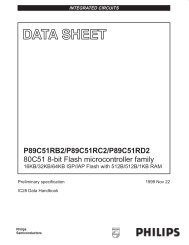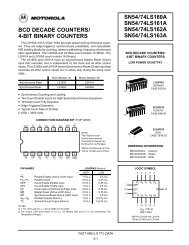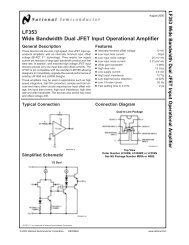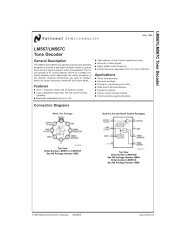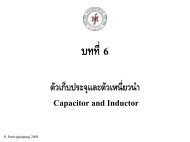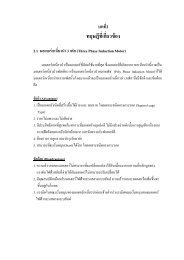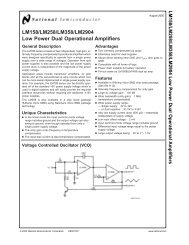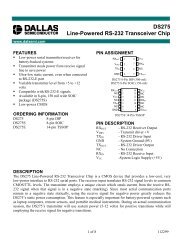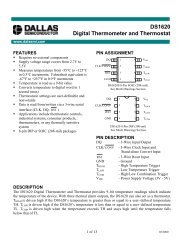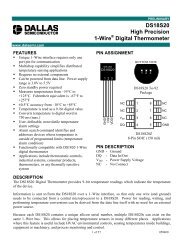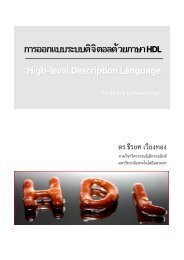A Possible 100 MSPS Altera FPGA FFT Processor
A Possible 100 MSPS Altera FPGA FFT Processor
A Possible 100 MSPS Altera FPGA FFT Processor
You also want an ePaper? Increase the reach of your titles
YUMPU automatically turns print PDFs into web optimized ePapers that Google loves.
A <strong>Possible</strong> <strong>100</strong> <strong>MSPS</strong> <strong>Altera</strong> <strong>FPGA</strong> <strong>FFT</strong> <strong>Processor</strong><br />
Grant Hampson<br />
March 12, 2002<br />
Introduction<br />
This document describes a <strong>FPGA</strong> implementation and simulation of the <strong>FFT</strong> component<br />
of the IIP Radiometer RFI processor described in [1]. The <strong>FFT</strong> processor will ideally<br />
be capable of processing <strong>100</strong>% of the input bandwidth (<strong>100</strong> <strong>MSPS</strong>.) The chosen <strong>FFT</strong><br />
length (1024) is a trade off of <strong>FFT</strong> bin width (approximately <strong>100</strong>kHz) and possible RFI<br />
detection.<br />
This document describes a possible implementation in an <strong>Altera</strong> <strong>FPGA</strong>, as opposed<br />
to currently available ASIC designs [2, 3]. These ASICs are capable of performing <strong>FFT</strong>s<br />
on <strong>100</strong> and 84 <strong>MSPS</strong> data streams continuously using two ASICS chained together (16W<br />
of power.) They come in large Ball Grid Array packages which may propose difficulties<br />
in assembly. There are many other <strong>FFT</strong> processors available [4], however most are<br />
significantly slower, or are sold as modules. Investigations are continuing in this area.<br />
This document is broken into three separate sections. The first section describes the<br />
<strong>Altera</strong> <strong>FFT</strong> Megacore. Secondly, simulation results are presented from the core. Finally,<br />
several ideas are proposed for a <strong>100</strong> <strong>MSPS</strong> <strong>FFT</strong> processor.<br />
1 <strong>Processor</strong><br />
An <strong>FFT</strong> core is available from <strong>Altera</strong> [5] for US$500 which can be evaluated for free. The<br />
core is fully programmable, with the main features being:<br />
• Data and twiddle widths of 8 to 24 bits precision<br />
• Floating point core with 3 to 8 bits precision<br />
• <strong>FFT</strong> length from 2 4 to 2 20<br />
The <strong>FFT</strong> Megacore can be connected to internal or external memory. Memory is required<br />
for temporary storage as well as ROM storage for the twiddle factors. The size and<br />
performance of the core is determined by<br />
• the processing requirements are mainly dependent on the data and twiddle widths,<br />
• the memory requirements are mainly dependent on the <strong>FFT</strong> length,<br />
• the performance is dependent on the number clock cycles to compute the <strong>FFT</strong>:<br />
clock cycles = 0.5 log 2 N × (14 + N + log 2 twiddle width) (1)<br />
1
A test bench for the <strong>Altera</strong> <strong>FFT</strong> Megacore function is provided by <strong>Altera</strong> for benchmarking.<br />
Table 1 illustrates the <strong>FFT</strong> processor sizes for two input data widths and two twiddle<br />
data widths. Increasing the size of the twiddle width increases memory and processing<br />
requirements. The maximum clock rate is also 20-30% above the available clock rate of<br />
<strong>100</strong>MHz.<br />
Table 1: Example compilation sizes and speeds of two popular input data widths for 8<br />
and 16 bit twiddle factors. The length of the <strong>FFT</strong> is 1024 points.<br />
Data Twiddle LE Memory Speed<br />
8-bit 8-bit 1344 20480 131<br />
16-bit 1722 20480 128<br />
10-bit 8-bit 1539 24576 125<br />
16-bit 2195 28672 105<br />
Another compilation example is shown in Figure 1 where the memory requirements of<br />
the <strong>FFT</strong> are shown to be linear with <strong>FFT</strong> length. The processing requirements (number of<br />
Logic Elements (LE)) varies only about 10% over all <strong>FFT</strong> lengths. The memory resources<br />
required for implementation will be a strong trade off against the <strong>FFT</strong> length. Shorter<br />
<strong>FFT</strong> lengths will be preferred over longer <strong>FFT</strong>s.<br />
<strong>100</strong>00<br />
8000<br />
Memory (bytes)<br />
#LE<br />
6000<br />
4000<br />
2000<br />
0<br />
0 <strong>100</strong>0 2000 3000 4000<br />
<strong>FFT</strong> Length<br />
Figure 1: Memory and processing requirements of the <strong>FFT</strong> core for various lengths of<br />
<strong>FFT</strong>s. The data and twiddle widths used here are both 8-bit.<br />
The <strong>FFT</strong> Megacore can be simulated with any type of data desired. A Matlab script<br />
generates the required input simulation files for Quartus and the resulting simulation wave<br />
forms can be saved and analyzed in Matlab. Figure 2 illustrates the simulation of a 1024<br />
point <strong>FFT</strong>. There are three main sections to the simulation. Firstly, input data is written<br />
into the <strong>FFT</strong> data memory. A ’go’ signal is activated and the <strong>FFT</strong> processes the data.<br />
When the <strong>FFT</strong> finishes a ’done’ signal is activated and the result can be read from the<br />
data memory.<br />
Since data is being sampled continuously, the writing of data to RAM doesn’t contribute<br />
to the overall processing time. The processing time is however, the time it takes to<br />
2
process the data, as well as, the time it takes to read data from the FIFO. Specifications<br />
of the core do not include this read time - just the <strong>FFT</strong> time.<br />
In this simulation the clock rate was set to the input data rate of <strong>100</strong>MHz. However,<br />
as Table 1 suggests there could be a gain of 25% by increasing the processing clock rate<br />
to its maximum. Problems may however arise in the different clock rates. Once again<br />
the specifications used the maximum clock rate. The following sections measure the<br />
throughput of the <strong>FFT</strong> Megacore using a data and processing rate of <strong>100</strong>MHz.<br />
Figure 2: Example simulation of a <strong>FFT</strong> implementation using the <strong>Altera</strong> <strong>FFT</strong> Megacore.<br />
Three distinct sections can be seen in the simulation. The first is loading input data into<br />
the memory, secondly is the <strong>FFT</strong> processing time, and thirdly reading of the results.<br />
2 <strong>FFT</strong> <strong>Processor</strong> Results<br />
Simulations of the <strong>FFT</strong> core were done to verify correction operation of the core and to<br />
see the effects of data and twiddle widths. Figure 3 illustrates one such result where 16-bit<br />
twiddle factors were used to compute the <strong>FFT</strong> of a sinusoid plus noise. Small differences<br />
exist between the Matlab computed <strong>FFT</strong> and the Megacore output - most of which seem<br />
to be effected by dynamic range of the output. A simulation of 8 and 16 bit twiddle<br />
factors showed little difference between outputs - the average error was almost identical.<br />
Increasing the number of output data bits would most likely have a greater effect. The<br />
<strong>FFT</strong> Megacore however fixes the number of output bits to be identical to the number<br />
of input bits. In order to increase the number of output bits the input width has to be<br />
increased, thus increasing the processing requirements.<br />
The next, and probably most important tests to be conducted were to measure the<br />
processing capabilities of the Megacore. Figure 4 illustrates the results of six simulations<br />
with different <strong>FFT</strong> lengths (from 128 to 4096.) The time was recorded for the <strong>FFT</strong><br />
processing time and the time to read the data from the SRAM. From the total time it is<br />
possible to calculate the throughput. For shorter <strong>FFT</strong>s the throughput is as high as 18<br />
<strong>MSPS</strong> and for longer <strong>FFT</strong>s it is as slow as 14 <strong>MSPS</strong>. For 1k <strong>FFT</strong>s the throughput is 16.4<br />
<strong>MSPS</strong> which is far from the desired <strong>100</strong> <strong>MSPS</strong> (1/7th the desired rate.)<br />
3
0<br />
−10<br />
Matlab <strong>FFT</strong><br />
<strong>FPGA</strong> <strong>FFT</strong><br />
Power (dB)<br />
−20<br />
−30<br />
−40<br />
−50 0 50<br />
Frequency (MHz)<br />
Figure 3: Example simulation of a <strong>FFT</strong> implementation using the <strong>Altera</strong> <strong>FFT</strong> Megacore<br />
with 8-bit inputs and 16-bit twiddle factors. There is little difference between the Matlab<br />
<strong>FFT</strong> and <strong>FPGA</strong> <strong>FFT</strong>. The greatest effect is the limited dynamic range of the output (8-<br />
bits) reducing the effect of 16-bit twiddle factors. 8-bit twiddle factors produced almost<br />
identical errors.<br />
250<br />
200<br />
150<br />
<strong>100</strong><br />
50<br />
Read (µsec<br />
Process (µsec)<br />
<strong>FFT</strong> Throughput (<strong>MSPS</strong>)<br />
19<br />
18<br />
17<br />
16<br />
15<br />
0<br />
0 <strong>100</strong>0 2000 3000 4000<br />
<strong>FFT</strong> Length<br />
(a) <strong>FFT</strong> processing and reading times<br />
14<br />
0 <strong>100</strong>0 2000 3000 4000<br />
<strong>FFT</strong> Length<br />
(b) Single <strong>FFT</strong> processor throughput<br />
Figure 4: Results for various length <strong>FFT</strong>s for 8-bit inputs and twiddle factors. (a) The<br />
recorded processing and read times for the <strong>Altera</strong> <strong>FFT</strong> Megacore. (b) The calculated<br />
throughput based on the total processing time and read time.<br />
4
3 A <strong>Possible</strong> <strong>100</strong> <strong>MSPS</strong> <strong>FFT</strong> <strong>Processor</strong><br />
A brute force technique of increasing the throughput of the <strong>FFT</strong> Megacore is to do parallel<br />
processing. Instead of having only one core operating it is possible to have multiple<br />
<strong>FFT</strong> cores. Several factors then become quite important - <strong>FFT</strong> memory and processing<br />
requirements - since everything is now multiplied by M (the number of cores.)<br />
Firstly, it is important to consider what <strong>FPGA</strong> sizes currently available on the market.<br />
Figure 5 illustrates the characteristics of four available <strong>FPGA</strong>s [6]. These <strong>FPGA</strong> sizes<br />
are all available in Quad Flat Packs (QFP) which are relatively easy to assemble. Larger<br />
<strong>FPGA</strong>s are available in Ball Grid Array (BGA) packages.<br />
12000<br />
1.5 x 105<br />
Logic Elements<br />
<strong>100</strong>00<br />
8000<br />
6000<br />
Memory (Bits)<br />
1<br />
4000<br />
<strong>100</strong> 150 200 250 300<br />
<strong>FPGA</strong> Type<br />
(a) <strong>FPGA</strong> Logic Elements<br />
600<br />
0.5<br />
<strong>100</strong> 150 200 250 300<br />
<strong>FPGA</strong> Type<br />
(b) <strong>FPGA</strong> Memory Sizes<br />
500<br />
Device Cost<br />
400<br />
300<br />
200<br />
<strong>100</strong><br />
<strong>100</strong> 150 200 250 300<br />
<strong>FPGA</strong> Type<br />
(c) <strong>FPGA</strong> Cost<br />
Figure 5: <strong>Altera</strong> APEX series of <strong>FPGA</strong>s come in 10 different sizes (with many other<br />
possible mutations.) Four sizes suitable for implementation of the multi-<strong>FFT</strong> core are<br />
shown here; the EP20K<strong>100</strong> (144-pins), EP20K160 (144-pins), EP20K200 (208-pins) and<br />
EP20K300 (240-pins). (a) illustrates the number of logic elements within the <strong>FPGA</strong>, (b)<br />
shows the available memory resources, and (c) shows the device cost. The cost function<br />
seems directly proportional to the <strong>FPGA</strong> hardware.<br />
5
Next consider the implementation of a multi-<strong>FFT</strong> core processor. For a 10-bit input<br />
data width and using 8-bit twiddle factors, requires 1539 LE and 24576 bits of memory.<br />
Multiplying this by 8 to achieved the desired throughput requires 12312 LE and 196608<br />
bits of memory. Given that a safe fill factor of <strong>FPGA</strong>s is approximately 75% of their<br />
resources - none of the available <strong>FPGA</strong>s are suitable. A technique to overcome this would<br />
be to use two <strong>FPGA</strong>s, as shown in Figure 6. Each <strong>FPGA</strong> would contain four <strong>FFT</strong> cores,<br />
and output multiplexer. The master <strong>FPGA</strong> would contain a controller for both <strong>FPGA</strong>s.<br />
The master controller also generates read and write addresses (all identical) which are<br />
not shown to simplify the drawing.<br />
Complex<br />
Data In<br />
Write Read<br />
<strong>FFT</strong><br />
Data Data<br />
Write Read<br />
<strong>FFT</strong><br />
Data Data<br />
0<br />
1<br />
Write Read<br />
<strong>FFT</strong><br />
Data Data<br />
Write Read<br />
<strong>FFT</strong><br />
Data Data<br />
2<br />
3<br />
0<br />
1<br />
Complex<br />
<strong>FFT</strong> Out<br />
Master Controller<br />
Write Read<br />
<strong>FFT</strong><br />
Data Data<br />
Write Read<br />
<strong>FFT</strong><br />
Data Data<br />
0<br />
1<br />
Write Read<br />
<strong>FFT</strong><br />
Data Data<br />
2<br />
Write Read<br />
<strong>FFT</strong><br />
Data Data<br />
3<br />
Figure 6: Example implementation of a multi-<strong>FFT</strong> core processor evenly distributed over<br />
two <strong>FPGA</strong>s. If the <strong>FFT</strong>s used are 10-bit data, 8-bit twiddle and length 1024, 53% of LE<br />
and 67% of the memory are used in a EP20K300 device.<br />
6
Given that there are now four <strong>FFT</strong> cores per <strong>FPGA</strong>, this would load an EP20K300<br />
with 53% of the Logic Elements and 67% of the memory. This provides adequate room<br />
for the controller and multiplexers. Additional hardware may also be required for the<br />
implementation of the Bartlett window and power integration described in [1].<br />
Next, consider the timing of the multi-<strong>FFT</strong> core design. An example timing diagram<br />
is shown in Figure 7. Here a length 1k <strong>FFT</strong> is implemented using 10-bit inputs and<br />
8-bit twiddle factors. The number of clock cycles required to compute the <strong>FFT</strong> can be<br />
calculated from Equation 1, which equals 5205 clock cycles. The timing diagram starts<br />
by writing data to RAM-0 which takes 1024 clock cycles. After 5205 clock cycles the <strong>FFT</strong><br />
processing is finished. During this processing each of the <strong>FFT</strong> RAM blocks are written to<br />
in succession. There is a small delay of 939 clock cycles between the <strong>FFT</strong> finishing and<br />
the RAM being read. After reading the whole cycle starts again.<br />
The controllers for the multi-<strong>FFT</strong> core processor might be implemented as a master<br />
controller initializing the start time of 8 smaller identical controllers. In this way the<br />
smaller controllers should have no speed limitations. Each smaller controller will simply<br />
start writing at n = 0, stop writing at n = 1024, start reading at n = 7168, stop writing<br />
at n = 8192. The timing diagram will scale linearly if the <strong>FFT</strong> length changes.<br />
1024+5205<br />
n=0 1024 =6229 7168 8192<br />
8192+1024+5205<br />
=14421 15360<br />
16384<br />
<strong>FFT</strong> Processing<br />
<strong>FFT</strong> Processing<br />
<strong>FFT</strong>0<br />
Wr−0<br />
Rd−0 Wr−0<br />
Rd−0<br />
<strong>FFT</strong>1<br />
Rd−1 Wr−1<br />
Rd−1 Wr−1<br />
<strong>FFT</strong>2<br />
<strong>FFT</strong>3<br />
<strong>FFT</strong>4<br />
<strong>FFT</strong>5<br />
<strong>FFT</strong>6<br />
<strong>FFT</strong>7<br />
Rd−2 Wr−2<br />
Rd−3 Wr−3<br />
Rd−4 Wr−4<br />
Rd−5 Wr−5<br />
Rd−6 Wr−6<br />
Rd−7 Wr−7<br />
Rd−2 Wr−2<br />
Rd−3 Wr−3<br />
Rd−4 Wr−4<br />
Rd−5 Wr−5<br />
Rd−6 Wr−6<br />
Rd−7 Wr−7<br />
Figure 7: Example timing diagram of an eight <strong>FFT</strong> core processor.<br />
4 The Floating Point Nature of the <strong>FFT</strong> Megacore<br />
It was noted in Section 1 that the <strong>FFT</strong> Megacore uses a floating point mechanism to<br />
improve resolution of the result. Additional to the data outputs is a bus which contains<br />
the exponent (3 to 8-bits wide.) As a result, the output data needs to be scaled by this<br />
exponent in order to have any relative sense. This could be implemented using a large<br />
multiplexer. Alternatively, the floating point output could however be useful in a floating<br />
point multiplier (such as the power estimator.) Further work is required here.<br />
7
Summary and Conclusions<br />
This report has presented a possible <strong>100</strong> <strong>MSPS</strong> <strong>Altera</strong> <strong>FPGA</strong> <strong>FFT</strong> processor implementation.<br />
The <strong>Altera</strong> <strong>FFT</strong> Megacore is available for $500. The Megacore was implemented in<br />
various sizes to evaluate the processing and memory requirements, as well as the operating<br />
performance.<br />
The <strong>FFT</strong> Megacore was found to have a fraction of the throughput required. Consequently,<br />
a design which contains eight <strong>FFT</strong> processors operating in parallel was presented.<br />
The proposed design could be implemented in two EP20K300EQC240-1 <strong>Altera</strong> <strong>FPGA</strong>s.<br />
This <strong>FPGA</strong> has a 240-pin QFP foot print and each <strong>FPGA</strong> costs $512 (www.arrow.com).<br />
This brings the total cost of the <strong>100</strong> <strong>MSPS</strong> <strong>FFT</strong> to $1524.<br />
The proposed <strong>FFT</strong> processor has the limitation that the <strong>FFT</strong> length cannot exceed<br />
1024 - unless the throughput is sacrificed. The main limitation of larger <strong>FFT</strong> lengths is the<br />
required memory. The <strong>FFT</strong> length can be shorter than 1024 with no drop in performance.<br />
Using the proposed implementation of a 1024-point <strong>FFT</strong> with 10-bit inputs and 8-bit<br />
twiddle factors will leave ample room for extra processing such as windowing and power<br />
estimation in the same <strong>FPGA</strong>s.<br />
References<br />
[1] S. W. Ellingson, “Design Concept for the IIP Radiometer RFI <strong>Processor</strong>,” January<br />
23 2002. http://esl.eng.ohio-state.edu/rfse/iip/rfiproc1.pdf.<br />
[2] 1K complex full-floating point <strong>FFT</strong> in 10 us, Double BW, 2000.<br />
http://www.doublebw.com/<strong>FFT</strong>Engine.htm.<br />
[3] RDA 108 - Single Chip <strong>FFT</strong>, Radix Technologies.<br />
http://www.radixtek.com/rda108.htm.<br />
[4] B. M. Baas, “<strong>FFT</strong> Information Page,” October 25 2001. http://wwwstar.stanford.edu/<br />
bbaas/fftinfo.html.<br />
[5] <strong>FFT</strong> MegaCore Function User Guide, <strong>Altera</strong> Corporation, March 2001.<br />
http://www.altera.com/literature/ug/fft ug.pdf.<br />
[6] APEX 20K: Programmable Logic Device Family, <strong>Altera</strong> Corporation, December 2001.<br />
http://www.altera.com/literature/ds/apex.pdf.<br />
8



